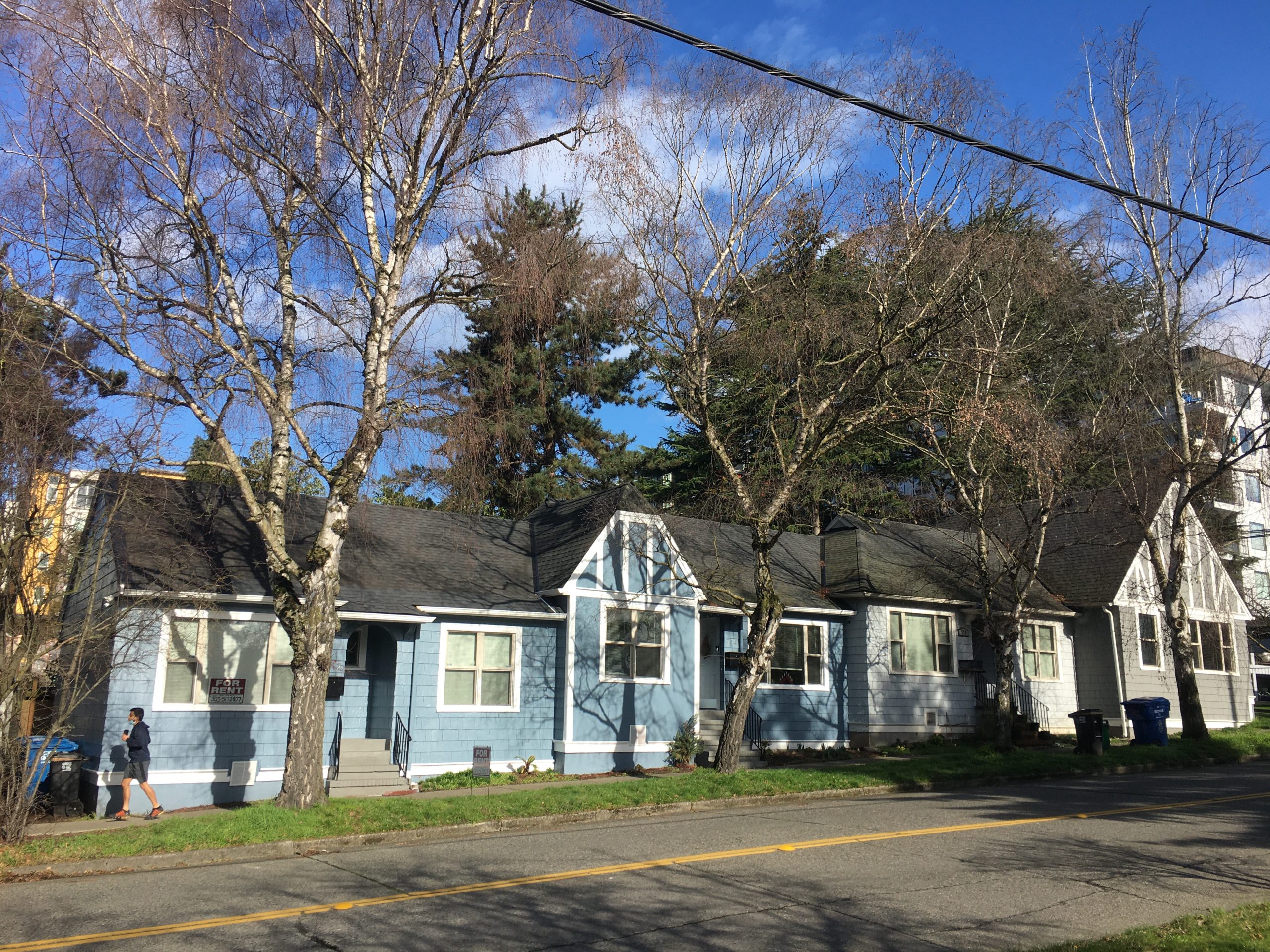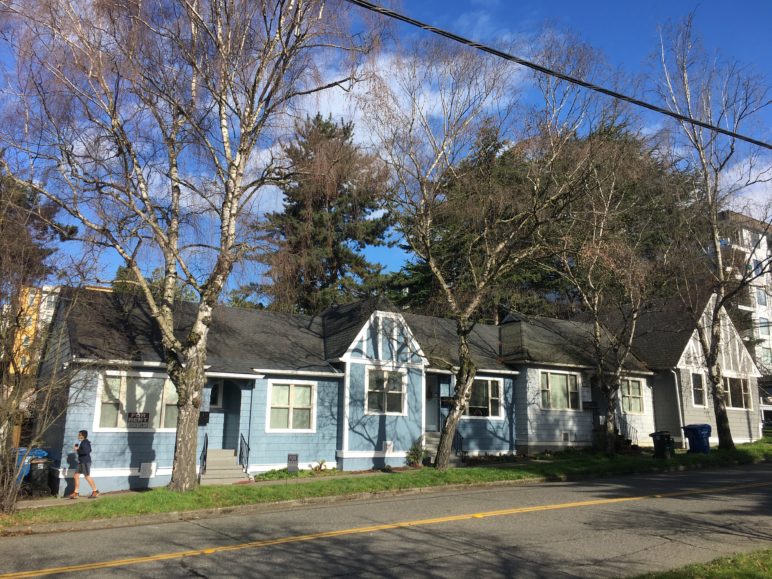UPDATE, April 19: The Senate Ways and Means Committee held a public hearing on HB 1157 on April 5 but subsequently declined to take a vote, killing the bill.
UPDATE, March 28: HB 1157 passed the in the House by a 93 – 4 vote.
UPDATE, February 22: HB 1157, its companion SB 5390, and SB 5269 all failed to make today’s cutoff for passing out of their respective finance committees. However, HB 1157 has been deemed “necessary to implement the budget” (NTIB), keeping it alive.
UPDATE, February 17: The House Local Government Committee, chaired by Representative Gerry Pollet (D-Seattle), declined to take a vote on HB 1337, killing the bill. In better news, the Senate Housing & Local Government Committee passed SB 5235.
UPDATE, February 12: SB 5269 and HB 1157, along with its companion SB 5390, have all passed out of their first committees.
…
In Washington’s 2021 legislative session three bills add a new twist to remedies for the state’s crippling housing shortage: money cities can invest locally. In three different ways, these bills would offer local governments modest financial incentives in exchange for loosening zoning laws to allow more homes. All told, this local incentive approach for abundant housing has the potential to deliver a triple win: for cities, for the state, and for Washingtonians who need more homes, and more affordable choices, near their jobs, schools, and communities.
The idea is this: Local elected officials who feel the sting of rising home prices and rents in their communities and would otherwise champion affordability measures often hear the most vocal opposition to zoning changes from residents who own homes (and who also vote most regularly). Meanwhile, most local governments are budget-starved—exacerbated by the pandemic’s economic wreckage. The chance to put new dollars toward city budget priorities while addressing local affordability imperatives has the potential to tip the scales for local electeds toward embracing zoning reform.
It’s a new approach in Washington state, and as far as I know, no other US state has tried it at any significant scale. Outside the US, Germany demonstrates the potential of the concept. There, as my Sightline colleague Michael Andersen wrote, “an equalization grants system redistributes a share of tax revenue on a per-person basis—giving every German city a very concrete fiscal reward for adding population.” And to add population, you need zoning that lets you add homes.
Could it be a game changer for abundant housing policy in Washington?
A yes/and approach to “local control”—options and incentives for cities with state-level standards
Historically in the US, local governments have had almost complete control over zoning rules. But as acute housing shortages have driven rents and home prices skyward in job-rich regions across the nation—notably on the west coast—state lawmakers have begun to set statewide standards acknowledging that housing demand, commutes, and job markets all cross municipal boundaries. But city councils and their constituents have been cautious when it comes to giving up local control over zoning decisions, often mounting significant opposition to state-level abundant housing solutions.
Washington’s push for standards to allow more homes of all shapes and sizes across the state started in 2019 with bills to reform rules for accessory dwelling units (ADUs), legalize middle housing (small multi-dwelling homes like fourplexes and townhouses), and boost allowed housing density near transit stations. Legislators protective of local control, along with like-minded city officials and their lobbyists, weren’t interested. The bills went nowhere. But a conversation started about how to address the state’s housing crisis.
In 2020, lawmakers sponsored another ADU bill, but couldn’t pass it until it was watered down to a thin imitation of its original intent: a ban on parking mandates near transit (though even that small change was nonetheless an unprecedented milestone in policy that put homes for people over housing for cars). The same local control contingent again killed a middle housing bill, and also a bill to abolish discriminatory limits on the number of unrelated people allowed to share a home.
In the era of strapped city budgets, could incentives upend the politics?
For local electeds, new funding to fill holes in the municipal budget could provide a counterweight to vocal (and often powerful) minority opposition to abundant housing solutions that shift what kinds of homes are permitted in low-density neighborhoods. Policymakers could broaden support by committing the dollars to high-priority local needs favored by their constituents. It both empowers local decision-making and local spending.
Also, all three of the proposed Washington bills are totally optional. Local governments retain the freedom to opt out. Cities could choose to keep their status quo exclusionary zoning laws and forgo the financial assistance offered by the state. Or they could choose options to lift restrictions on more homes and a range of home types, and decide how they’ll spend the incentives in their communities.
For the state, the obvious concern is whether the abundant housing incentives could drain state dollars into local coffers. Washington’s budget has been gutted by the COVID-19 economic shutdown (though not as badly as originally feared), and is already under added strain from funding pandemic relief. However, if the zoning reforms mandated by the bills spur home construction that wouldn’t have happened otherwise, the state will take in more revenue from sales taxes, real estate excise taxes, and especially property taxes over the long term.
The politics are promising. Incentives may give cities the political tools they need to overcome local opposition and dismantle the walls of exclusion that zoning rules have built up around many neighborhoods. The budgets of both cities and the state stand to come out ahead. And not least, the bills will unlock the creation of homes that more Washingtonians can afford.
A successful abundant housing experiment to offer cities carrots: HB 1923
In 2019 Representative Joe Fitzgibbon sponsored HB 1923, a bill that in its original form would have required cities to adopt a minimum number of zoning-related reforms to increase housing. Cities opposed it until legislators weakened it to an opt-in bill, and also sweetened it with $100,000 state grants for jurisdictions planning to adopt the bill’s now optional provisions. The success of this approach in creating a winning political coalition informed the design of three bills before the legislature now.
Bill #1: Local grants for more ADU homes
(See also this subsequent article.) Representative Mia Gregerson sponsored HB 1337, which offers grants to local governments if they opt to enact state-approved regulations for accessory dwelling units (ADUs). Cities and counties can qualify for a stream of $10,000 grants—one per ADU actually built—by adopting a menu-based set of provisions to:
- allow owners to decide whether or not to install off-street parking spaces, rather than requiring them at each ADU
- allow owners to rent out both a house and its ADU, rather than requiring the owners to live on site (a requirement not imposed on any other form of housing!)
- raise limits on the size and number of ADUs
- cap minimums for lot size and setbacks
- minimize permit and impact fees
- remove mandates on aesthetics
Only the number of new ADUs in excess of the historic baseline production rate—that is, those created as a result of the code changes adopted—count toward a city’s total grant. The grant value per ADU of $10,000 is approximately equal to the amount of state sales tax collected on the construction of an average ADU.
For example, if a typical city of 50,000 passed the required reforms and annual ADU production rose from the historic baseline average of 5 per year to 30 per year, the city would be eligible for an annual grant of $250,000. Notwithstanding the expense of these grants, state tax revenues would increase over time through increased property taxes on ADUs that otherwise would not have been built.
A key feature if bill is that it would reward cities for actual homes built, not just for revising their laws. A 1993 Washington law legalized ADUs statewide, but most cities retained a gauntlet of restrictions that held ADU construction to a trickle, rendering the law nearly meaningless.
Bill #2: Property tax incentives to legalize middle housing
Senator Mona Das sponsored SB 5269, which allows cities and counties to exceed the one percent cap on annual property tax revenue increases if they opt to legalize middle housing types in their zones currently reserved for single-detached houses.
Middle housing types include duplexes through sixplexes, townhouses, and cottage clusters, and for each type, the bill specifies a percentage of the jurisdiction’s single-detached zoned land that must allow it. The bill also sets maximums for off-street parking mandates that depend on the middle housing type and the size of the lot.
The bill would enable jurisdictions to establish levy lid lift districts covering part or all of their land. Within a district, once the required zoning changes were made, the jurisdiction would be authorized to exceed the state’s one percent cap by counting both new construction and the appreciation of existing property towards the increase in the total property tax assessed, and thus collect more revenue than allowed under existing law.
Initial estimates project that a typical city of 50,000 that created a lid lift district covering 10 percent of its total property value could collect an additional $200,000 to $400,000 per year in property tax.
The advantage of the property tax bill, compared with the ADU grants bill, is that it covers many more types of housing. Of course, the two laws are compatible, not competitive.
Bill #3: REET rebate for increased housing capacity
Newly elected Representative Jessica Bateman sponsored HB 1157, which offers local governments a partial rebate of the Real Estate Excise Tax (REET) on new home sales if they opt to allow a minimum density of six homes per acre and to legalize a standard set of middle housing types.
The bill grants cities and counties authority to establish REET rebate zones, within which they must enact the required land use rules to qualify new home sales for the rebate. It would refund to jurisdictions between one quarter and one half of the REET, but only on new homes that could not have been built without the zoning changes.
So for example, in a case where previous zoning allowed one home on a lot and the reformed zoning allows four, then if four new homes get built, three of them qualify for the REET rebate. This makes it clear that the REET rebate program would not rob the state of tax revenue, because without the program, the REET from those three extra homes wouldn’t exist at all.
Washington’s progressive REET ranges from 1.1 to 3.0 percent depending on sale price. For the sale of a $500,000 home, the REET is $5,500. If builders constructed 100 new qualifying homes at that price in a city, it would get a REET rebate of between $137,500 and $275,000. (One flaw in Washington’s REET is that most apartment buildings get hit with the highest rate even though their individual units would likely qualify for the lowest rate if sold separately. But that also means apartments are likely more lucrative for cities getting REET rebates.)
Like the ADU grants bill, the REET rebate bill rewards cities for extra homes actually built, not just for law changes. It’s also compatible with both of the others. The state can adopt all three, and let cities decide whether and which to opt into.
Does this new abundant housing incentive approach have legs?
We’ll soon find out if the three bills can survive the legislative process. They come up for debate starting next week.
If any of the three pass, the next question is: will cities opt in? Preliminary feedback from city officials indicates that the projected level of financial assistance is enough to be a motivational incentive. However, one weakness of the model is that wealthy cities—places that commonly have the worst exclusionary zoning—may be inclined to decline participation because they don’t need the money.
Each of the three bills is a promising model for importing the German model of incentivizing cities to allow more homes for more people. With these bills, Washington lawmakers have the opportunity to become national leaders on state-level housing policy to ease the housing crisis.
…
SB 5269 gets its first hearing in the Senate Housing & Local Government Committee on January 27 at 10:30am. To testify (live at the hearing or in writing), or to officially register support for the bill, go here: https://app.leg.wa.gov/CSIRemote/Senate. Then select the committee and the 1/27 10:30am hearing, and follow the instructions.
HB 1157 gets its first hearing in the House Local Government Committee on January 27 at 10:00am. To testify (live at the hearing or in writing), or to officially register support for the bill, go here: https://app.leg.wa.gov/CSIRemote/House. Then select the committee and the 1/27 10:00am hearing, and follow the instructions.
HB 1337 is scheduled for its first hearing in the House Local Government committee on February 3 at 10am. Up to one hour prior to the hearing start time, anyone register their support or sign up to testify live at the hearing. Written testimony can be submitted up to 24 hours after the hearing start time. Start at this link, choose the Local Government committee and then HB 1337.
Supporters can also contact the committee members:
Gerry.Pollet@leg.wa.gov (Chair)
Davina.Duerr@leg.wa.gov (Vice Chair)
Keith.Goehner@leg.wa.gov
Dan.Griffey@leg.wa.gov
April.Berg@leg.wa.gov
Eric.Robertson@leg.wa.gov
Tana.Senn@leg.wa.gov
Sightline Institute is a 501(c)3 non-profit organization and does not support, endorse, or oppose any candidate or political party.
For press inquiries and interview requests, please contact Anna Fahey.











Kevin Johnson
Worst plan ever. Law makers have lost connection with the true problem. We are a small landlord which always offered affordable housing with most homes rented at 800-900 per month. The problem is high taxes in the 1st place. 20 years ago our property taxes were approx the same as 1 months rent, now 3-4 months rent and with higher state & county taxes when you sell, Governor wants a to impose a cap gains tax on the eventual sale as well. Now with COVID, renters don’t have to pay rent & you have to provide utilities, you can’t raise rents or refuse to rent to those with recent eviction history. I know many other small landlords having the same issues that are choosing to just warehouse any vacant rental homes. Fix the taxing & rent payment issues and landlords will open doors. With all this why would you want to be a landlord with all these cards stacked against you.
Dan Bertolet
Kevin –
I hear you that property taxes contribute to higher rents. I support extending Washington’s multifamily tax exemption to existing buildings that charge low rents, such as you describe in your building.
On bill #2, the additional property tax revenue generated by new construction would offset some of the tax increase resulting from the lid lift, hard to say how much.
Bills #1 and #3 would likely ease the property tax burden because they would stimulate new construction that wouldn’t have happened otherwise.